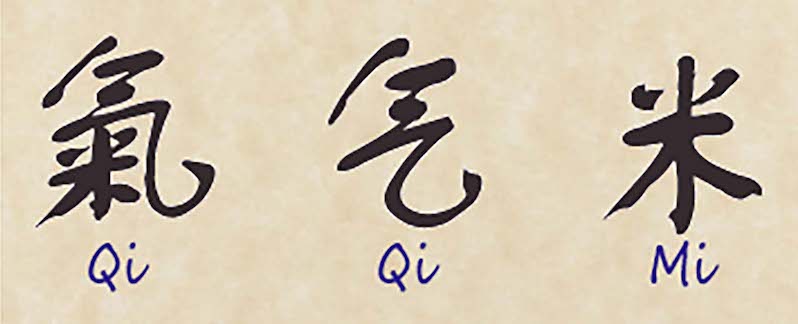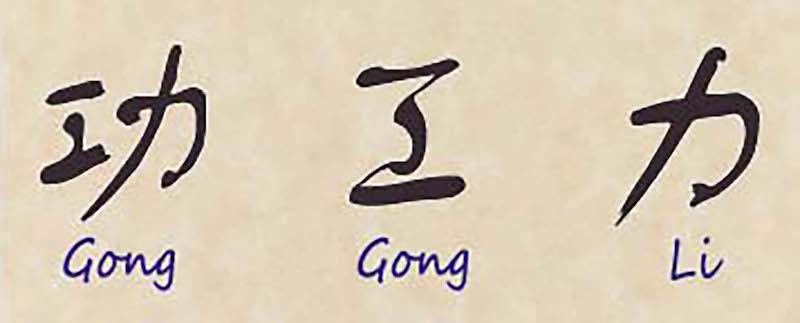If the disparity between the Tai Chi versus Taiji spellings is confusing, Chi Kung and Qigong is even more bothersome. To reiterate from the previous essay on the topic, it’s all about how Chinese was romanized from logographic characters into letters of the alphabet. To start, capitalization doesn’t exist with Chinese characters. That’s an alien concept to logographic languages. Chinese also has some different sounds than English that don’t fall neatly into the sounds described by the alphabet.
Chi Kung is the older spelling and it’s closest to the sound of the word for English speakers unfamiliar with pinyin romanization. Qigong is the newer pinyin spelling. In pinyin, the Q is pronounced like ‘CH’ in ‘chin.’ This begs the question ‘Why doesn’t pinyin just use ‘CH’ for ‘CH’ sounds?’ After all, the CH is used in words like Chin Na and Chen Tai Chi.
The distinction between Q and CH in pinyin is subtle, almost undetectable to a non-Chinese ear. It has to do with where you place your tongue. Most English speakers let the tongue lie flat when voicing the ‘ch’ sound. For the pinyin Q, the mouth shape and voicing are similar, but the tongue is curled back in a higher position against the hard palette. Try it. Make the CH sound like you always do and then try it with the tip of your tongue starting at the roof of your mouth. It makes a slightly different sound, something easy to miss if you’re not attuned to listening for it. The alphabet doesn’t have a letter that can accommodate this difference, so the Q was awkwardly deployed instead. It’s an annoying compromise because the uninitiated will to ask ‘What’s kwee-gong?’ But for anyone who attempts to learn Mandarin, it’s a critical distinction.
If Google is used as a barometer of popularity, Chi Kung is the more popular term. Chi Kung gets 39,800,000 hits when searched while Qigong retrieves less than half of that, only 18,300,000 hits. However, the usage of Qigong is rising because pinyin is the official romanization system of Mandarin. It is what is used in any scholarly or legal treatment. Unfortunately, the popular dissemination of Qigong to the West is perpetually hobbled by that Q.
Many Spellings of Qigong
Just like with Tai Chi versus Taiji, Qigong suffers from different spellings (or more specifically, different logographs) in Chinese too. The communists simplified Chinese characters so there are now two representations for Qi – simplified and traditional. The traditional character combines two radicals. The first is Qi (气), which can mean steam or vapor. The second is Mi (米), which means hulled or husked uncooked rice. The combination of these two characters forms the traditional character for Qi (氣), which like the simplified version can also mean steam or vapor, as well as air or gas. Most importantly, it can also mean spirit. Many interpret this combination as a metaphor – the steam that rises from cooking rice. Here’s where it gets tricky. The new simplified character removes the rice. It’s just the first radical. Alone, this character is used as the simplified version.

Beyond the letters and characters, Qigong is tricky to translate. Of the two characters that comprise Qigong, Gong is easy so we’ll come back to that. Qi is challenging. Just like English lack a sound for the pinyin Q, there isn’t an analogous word to Qi. In the martial arts field, Qi is generally defined as a universal energy, something that circulates through all living creatures. It is important to recognize that this is a pragmatic definition. As an example of an exception to this definition, you can say that something inanimate could have ‘good qi’ like a painting, a sculpture, or any piece of art. You could say a space has ‘good qi’ if it has natural beauty or good Feng Shui.
Within Chinese, Qi has multiple definitions. Modern Chinese dictionaries list off scores of definitions; some include more than eighty different usages. When translating Chinese to English, it gets tricky when there is no single analog. Attempts to narrow the translation of Qi leave a lot behind. However, every Western practitioner needs a basic translation of Qi to frame their perspective, so something simple at first is best. Qi is an expansive term and the deeper you go, the more elusive it gets.
The Kung (功) in Chi Kung is the same Kung as in Kung Fu. In pinyin, Kung Fu is gongfu. Kung (or gong) combines two radicals, gong (工) which means work or labor and li (力) which means physical strength, power, or force. Combined to gong (功), it can mean achievement, merit, or good result. In the martial arts, it is conventionally translated as something akin to ‘skill achieved through great time and effort.’ That’s a bit wordy for one character but I admire the poetry of it.
Gong is already a simple character – only five strokes – so there’s no modern simplified version. Compare this to the traditional Qi which is ten strokes. Remove the rice and it reduces down to only four strokes.

Now an astute reader, having been exposed to the rectifications and standardizations made by pinyin might question the title of World Tai Chi Qigong Day. Tai Chi is ‘traditional’ and Qigong is pinyin. Why don’t the romanizations match? Why isn’t it World Tai Chi Chi Kung Day? Or why not World Taiji Qigong Day? It's like the differences in American versus British spellings of English. It’s either skillful defense (American) or skilful defence (British), never skillful defence nor skilful defense. Shouldn’t spellings be consistent?
In the previous article, the history of the conventional spelling of Tai Chi was explained, as juxtaposed with the pinyin version of Taiji. Tai Chi is the most familiar term. Using that Google barometer, The hit count for the Tai Chi spelling dwarves all the others on the order of 230,000,000. With Chi Kung coming in at 39,800,000, Qigong at 18,300,000, and Taiji, a mere 1,740,000, it wins for a position in the title.
However, matching the two top hit earners doesn’t work either. World Tai Chi Chi Kung Day reads horridly with the double Chi. It’s also misleading because the Chi in Tai Chi and the Chi in Chi Kung are two completely different words. This is why it’s Ji and Qi in pinyin. World Taiji Qigong Day is the most progressive but given that the Tai Chi spelling dominates the Taiji spelling by nearly 230 times, that’s just not ‘search engine optimized’ and in today’s world, it’s all about SEO.
This demonstrates where we are in the world with the spreading of these arts. Multiple complications arise when translating even our most fundamental terms from Chinese to English. There’s simplified versus traditional characters. And then there’s the vacillating romantization. But the most significant is the exact meaning of the words. The most important thing to understand about translation is it’s not always an X=X equation. Sometimes X=Y+Z. And other times, there’s no simple equivalent.
It’s reminiscent of that old song Ride the Tiger by Jefferson Starship:
It's like a tear in the hands of a western man
Tell you about salt, carbon and water
But a tear to a Chinese man
He’ll tell you about sadness and sorrow or the love of a man and a woman
For anyone new to the field, the simplest is best. And pop culture is content with a simple answer. For the more studious, translation can be a journey on to itself, a deep rabbit hole to be explored with perceptiveness and wonder.
World Tai Chi Qigong Day is observed on the last Saturday in April. For 2023, that falls on April 29th.
The above is an original article by Gene Ching, Staff Writer for YMAA Publication Center.




